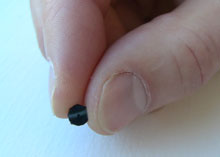기술동향
Simpler Genome Sequencing
- 등록일2011-05-17
- 조회수8851
- 분류기술동향 > 플랫폼바이오 > 바이오융합기술
-
자료발간일
2011-05-13
-
출처
Technology Review.
- 원문링크
-
키워드
#Genome Sequencing
Simpler Genome Sequencing
A startup hopes to make the technology cheap enough that it's feasible for a typical hospital lab.

Nanopore chip: This silicon chip is the core of a DNA-sequencing instrument being developed by startup Noblegen. At the center of the chip is an array of hundreds of nanoscale holes through which long sequences of DNA travel while being imaged.
Credit: Technology Review
Massachusetts startup called Noblegen is developing a simplified version of nanopore genome-sequencing technology—a technique that promises high speed and low costs but that usually requires complex instruments to carry out. Noblegen, founded last spring, says its technology's ability to directly and rapidly read DNA sequences could make it economically feasible to bring sequencing technology into clinical labs to diagnose cancer and other diseases.
Noblegen CEO Frank Feist says the company's goal is to sequence at a rate of 1000 bases per second. The company won't divulge details of its current prototypes, but says the technology could be scaled up to arrays of 400 by 400 nanopores that sequence over 500 gigabases an hour—or about one genome, covered 30 times, in 15 minutes.
Today, it takes about a month and $10,000 to $40,000 to sequence a human genome. The "next generation" sequencing technologies offered by companies including Illumina and Pacific Biosciences have come a very long way, says Jeffery Schloss, program director for technology development at the National Human Genome Research Institute, but "they leave a fair amount to be desired." These technologies vary, but in general, they require complex instrumentation. There are also limits on the length of the sequences they can read, and they don't read those sequences directly. This affects both the amount of time it takes to put the sequence together and the quality of the data.
For over a decade, researchers have been working on nanopore sequencing, which could eliminate these problems by directly reading off the sequence of long, unprocessed strands of DNA. The principle is to identify each base in the sequence as the molecule is threaded through a nanoscale hole (or nanopore) outfitted with a sensor.
But integrating all the parts and making them work has been challenging. For example, some systems read out the bases by sensing their electrical field; this requires a processing circuit for each nanopore, and integrating large arrays of such systems is complex. One company, Oxford Nanopore, claims to have fully developed such a system, but has not named any product launch dates.
Noblegen uses optical imaging to identify the bases. This adds a step at the beginning, but the trade-off is that the instrumentation needed for imaging is much simpler. First, the Noblegen researchers convert genomic DNA into a synthetic version that's labeled with four different fluorescent dyes, one for each type of base. Each base in the original sequence is represented by one fluorescently labeled segment in the synthetic one.
The synthetic sequences are then directly read out by Noblegen's relatively simple instrument. It's based on a silicon chip that's drilled to create pores just a few nanometers in diameter; the chip is illuminated by an inexpensive laser. The long synthetic molecules, which are charged, are pulled through the hole by electrostatic forces. But they can't move too quickly, because the fluorescent labels are too big to fit through the pore. As the DNA moves through the pore one segment at a time, the labels pop off, creating a flash of light. This light is imaged by a simple CMOS sensor like the one in a digital camera.
Feist says Noblegen's goal is to aggressively drive down the cost and increase the speed of sequencing whole genomes to a point where it makes economic sense for hospital labs in the next decade or so. "We want to deliver whole genome sequencing in the [hospital] lab within the financial constraints of the health-care system," he says.
Noblegen has $4.2 million in funding from the National Human Genome Research Institute. Feist says most of that funding has gone into developing the instrumentation. He adds that the company will need another $15 million to develop an industrial-scale prototype.

